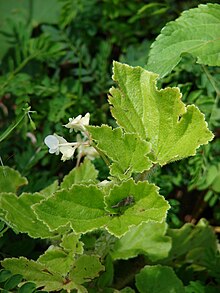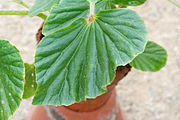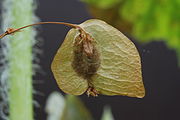
Begonia is a genus of perennial flowering plants in the family Begoniaceae. The genus contains more than 2,000 different plant species. The Begonias are native to moist subtropical and tropical climates. Some species are commonly grown indoors as ornamental houseplants in cooler climates. In cooler climates some species are cultivated outside in summertime for their bright colorful flowers, which have sepals but no petals.

Hypericum is a genus of flowering plants in the family Hypericaceae. The genus has a nearly worldwide distribution, missing only from tropical lowlands, deserts and polar regions. Many Hypericum species are regarded as invasive species and noxious weeds. All members of the genus may be referred to as St. John's wort, and some are known as goatweed. The white or pink flowered marsh St. John's worts of North America and eastern Asia are generally accepted as belonging to the separate genus TriadenumRaf.
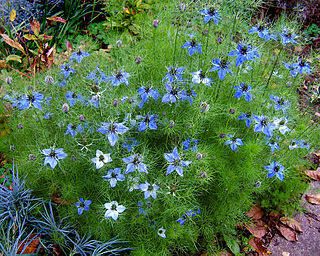
Nigella damascena, love-in-a-mist, or devil in the bush, is an annual garden flowering plant, belonging to the buttercup family Ranunculaceae. It is native to southern Europe, north Africa and southwest Asia, where it is found on neglected, damp patches of land.
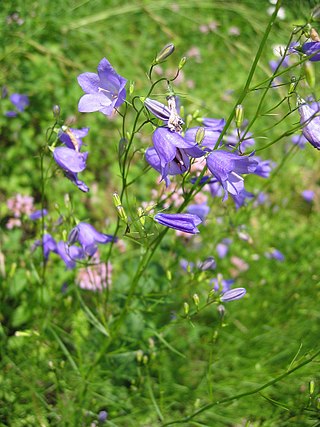
Campanula rotundifolia, the harebell, Scottish bluebell, or bluebell of Scotland, is a species of flowering plant in the bellflower family Campanulaceae. This herbaceous perennial is found throughout the temperate regions of the northern hemisphere. In Scotland, it is often known simply as bluebell. It is the floral emblem of Sweden where it is known as small bluebell. It produces its violet-blue, bell-shaped flowers in late summer and autumn.

Hyacinthus orientalis, the common hyacinth, garden hyacinth or Dutch hyacinth, is a species of flowering plant in the family Asparagaceae, subfamily Scilloideae, native to southwestern Asia, southern and central Turkey, northwestern Syria, Lebanon and northern Israel. It was introduced to Europe in the 16th century. It is widely cultivated everywhere in the temperate world for its strongly fragrant flowers which appear exceptionally early in the season, and frequently forced to flower at Christmas time.

Begoniaceae is a family of flowering plants with two genera and about 2040 species occurring in the subtropics and tropics of both the New World and Old World. All but one of the species are in the genus Begonia. There have been many recent discoveries of species in the genus Begonia, such as Begonia truncatifolia which is endemic to San Vincente, Palawan. B. truncatifolia is smaller in size than other species of the genus Begonia and this new species is proposed Critically Endangered by standards set by the IUCN. The only other genus in the family, Hillebrandia, is endemic to the Hawaiian Islands and has a single species. Phylogenetic work supports Hillebrandia as the sister taxon to the rest of the family. The genus Symbegonia was reduced to a section of Begonia in 2003, as molecular phylogenies had shown it to be derived from within that genus. Members of the genus Begonia are well-known and popular houseplants.

Pittosporaceae is a family of flowering plants that consists of 200–240 species of trees, shrubs, and lianas in 9 genera. Habitats range from tropical to temperate climates of the Afrotropical, Indomalayan, Oceanian, and Australasian realms. The type genus is Pittosporum Banks ex Gaertn.

Stewartia malacodendron, the silky camellia, silky stewartia or Virginia stewartia, is a species of flowering plant in the family Theaceae. It grows slowly into a large deciduous shrub or small tree, typically 3–4.5 m (10–15 ft) tall, but sometimes as tall as 9 m (30 ft). It is native to the southeastern United States.
Richard Pearce was a British plant collector, who introduced the tuberous begonia to England, which led to the development of the hybrid begonias grown today.

Dillenia suffruticosa, also known as simpoh air, simpor, or CB leaf, is a species of Dillenia found in tropical South East Asia in secondary forest and swampy ground. It is a highly invasive weed in Sri Lanka.

Viscaria vulgaris, the sticky catchfly or clammy campion, is a flowering plant in the family Caryophyllaceae.

Begonia palmata is a species of plant in the genus Begonia of the family Begoniaceae. It is a small herb of height 20–90 cm tall. It is found in moist places, next to streams or under the shade. It is found in many parts of Asia, including eastern Himalayas.

Begonia cucullata, also known as clubbed begonia, is a species of the Begoniaceae that is native to South American countries of Argentina, Brazil, Paraguay, and Uruguay. A common garden plant and part of the section Begonia, it was described in 1805 by Carl Ludwig Willdenow (1765–1812). The specific epithet "cucullata" means "resembling a hood" or "hooded".

Hypericum coris, the heath-leaved St. John's wort, also called yellow coris, is a species of flowering plant in the family Hypericaceae, and is the type species of sect. Coridium. It is a low shrub, and it is found in Switzerland and northwestern Italy. The species has been a popular garden plant since the 18th century, valued for its long flowering period and for how well it adapts to cultivation.

Begonia rex, the king begonia, is a species of flowering plant in the family Begoniaceae. It is found from Arunachal Pradesh to southeast China, and has been introduced to Bangladesh, Cuba, and Hispaniola. It is a parent to over 500 cultivars in the Begonia Rex Cultorum Group of houseplants. Other parents in the multitude of crosses made during the creation of the Group include Begonia annulata, B. cathayana, B. decora, B. diadema, B. dregei, B. grandis, B. hatacoa, B. palmata, and B. xanthina.

Begonia heracleifolia, the star begonia, is a species of flowering plant in the family Begoniaceae. It is native to Mexico and northern Central America, and has been introduced to Cuba, Hispaniola, Puerto Rico, and Trinidad and Tobago. A widespread species that is adapted to drought, it possesses considerable genetic and morphological variation, particularly in leaf shape and patterning.
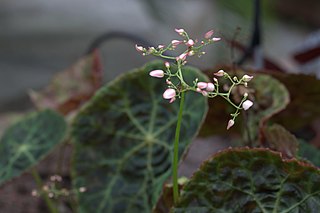
Begonia goegoensis, the fire-king begonia, is a species of flowering plant in the family Begoniaceae, native to Sumatra. In 1882 it was exhibited by Veitch and Sons and received a first class certificate from the Royal Horticultural Society. Valued for its striking red-backed leaves, it can be propagated from cuttings, although seeds may do better.
Begonia tenuifolia is a species of flowering plant in the family Begoniaceae, native to Sumatra, Java, and the Lesser Sunda Islands. A tuberous geophyte of the seasonally dry tropics, it has variable leaf patterning and coloration. The leaves of young plants are round, with mature plants having narrow, ovate leaves. Individuals can reach 25 cm (10 in), but some have been observed to flower when only 2 cm (0.8 in) tall. The seeds are dispersed by a splash cup structure.
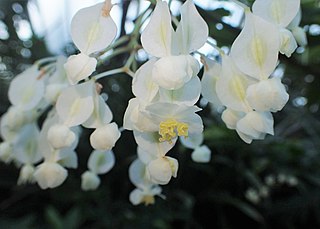
Begonia undulata, the wave leaved begonia, is a species of flowering plant in the family Begoniaceae, native to Rio de Janeiro state of Brazil. One of the more widely cultivated cane begonias, it is typically 1.8 m (6 ft) tall, but can reach 5.5 m (18 ft) if left to its own devices.
